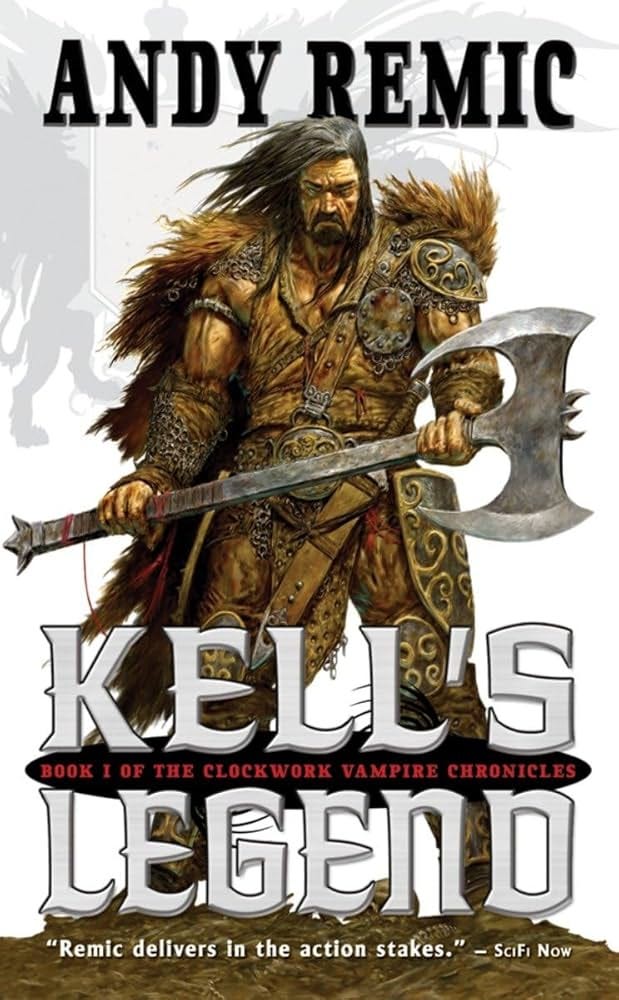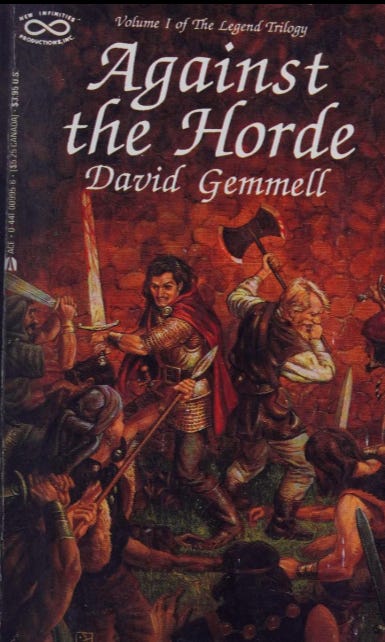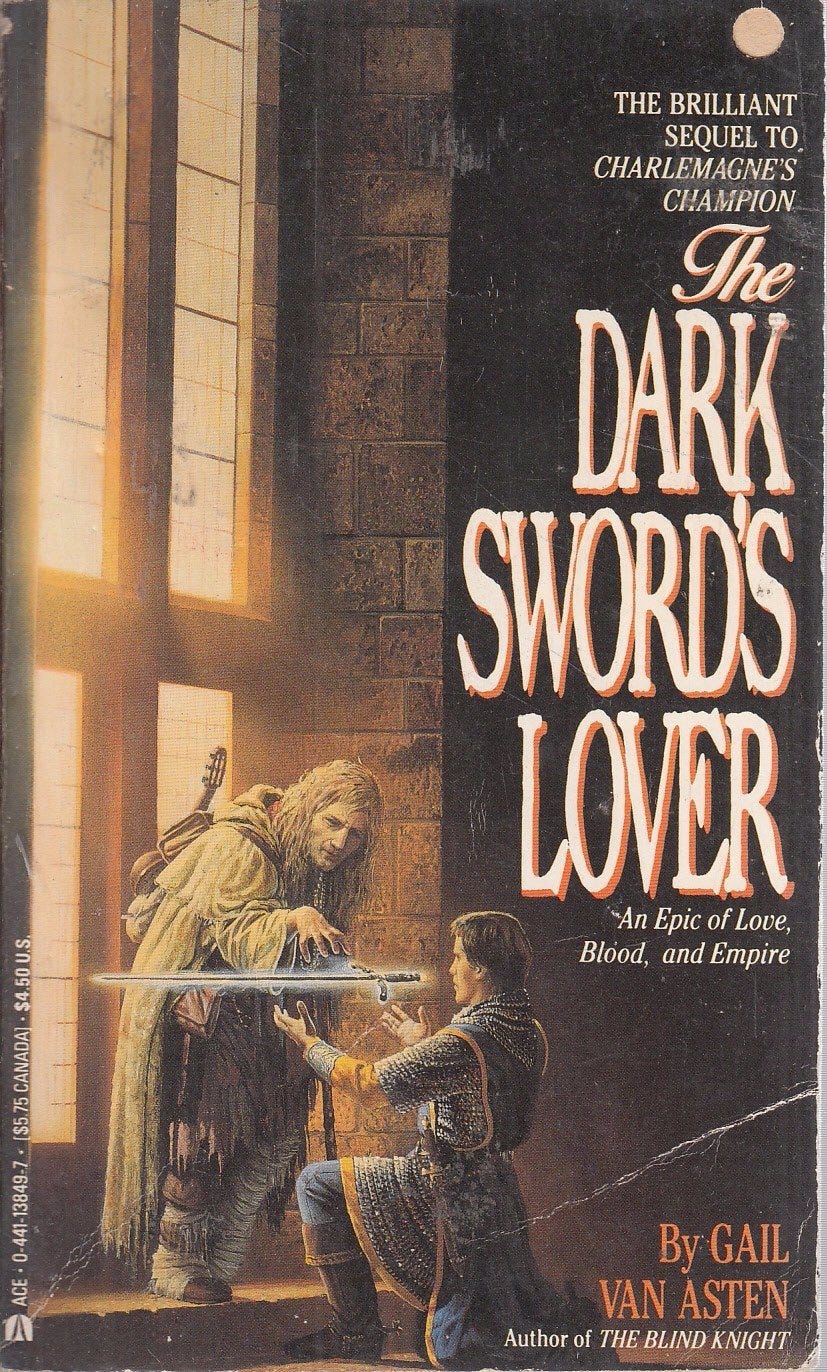Fantasy Retro-Review: Kell's Legend. "Hey, You Put Clockwork Magic in my Sword and Sorcery Story!"
It is often said that you cannot judge a book by its cover, but we know that isn’t entirely true. Marketing departments work hard to ensure that a book’s cover conveys a hint of what a book’s contents will be. The cover to Andy Remic’s book Kell’s Legend, which was published in 2010 by Angry Robot Books, practically screams at the potential reader.
“Psst! You! Yes, I mean you. You like David Gemmell’s Drenai Sagabooks right?!”
When David Gemmell died of coronary artery disease in 2006, it left a huge genre hole on the fantasy bookshelves of retailers around the world. David Gemmell was a master storyteller who wrote Sword & Sorcery tales that were adapted for modern readers. So when I saw the cover for Andy Remic’s novel in 2010, I was excited about the prospect of an author continuing to satisfy my pulp action reading itch is a pleasant one. Though David Gemmell was memorialized by with the David Gemmell Awards for Fantasy (there were two awards issued starting in the second year), many of the winners weren’t awarded for novels in the “Gemmell Style.” There were some great novels and novelists in those nominations, but in the first two years of teh awards it seemed that the committee was favoring traditional fantasy over Gemmellian fantasy.
Gemmell had a way of combining tried and true narrative tropes with interesting characters and pulse pounding action, to which he added a layer of religious and philosophic moral undertones. Gemmell’s originality as a writer wasn’t in plotlines. Some of his most famous books were adaptations of the Spartan stand at Thermopylae and stories of Scottish rebels. What made Gemmell such a great writer was his ability to create vulnerable and realistic human characters in a genre that too often presented ciphers.
I’ll take a moment to note that my first experience with a David Gemmell novel was due to Gary Gygax. His company New Infinities published the first three of Gemmell’s Drenai books: Legend (as Against the Horde), Waylander, and The King Beyond the Gate. It never ceases to amaze me how influential Gary Gygax was to my fantasy fiction tastes. The Appendix N he wrote for the Dungeon Masters Guide was one of the foundations of my early reading choices and the Gemmell books he published with New Infinities made me a life long fan.
When Angry Robot Books’s marketing department decided to publish a book and design a cover, that clearly evoked Gemmell to anyone familiar with his work, they set the bar to impress readers fairly high. Hinting that an author might be the next Gemmell isn’t quite saying they are the next Tolkien, but it is a pretty high bar in my opinion.
So, how did Remic fare?
Kell’s Legend -- the title even evokes Gemmell comparisons with the inclusing of Legend in the tilte -- opens with the massive Iron Army invading the relatively and stable Kingdom of Falador. How stable? The first discussion the protagonist has with his grand daughter is about her university education. The book opens with a defending army being completely routed by the Iron Army and after the initial description of the invasion, I did not hold much hope for the Kingdom of Falanor to resist the Iron Army. You see, the Iron Army is more than just a disciplined army comprised of skilled soldiers led by a talented commander invading at an opportune moment -- though it is all of those things -- it is also an army that has access to sinister “blood oil magic.” This magic can win battles before they even begin through the creation of a frightening pogonip like “ice fog” that can freeze defenders, and citizens, to death before the first blow is struck (you can see some great images of pogonip at this link).
The fact that his battles can be won without the enemy being able to fight back pleases the Iron Army’s General Graal for many reasons, not the least of which is that his army doesn’t merely seek to conquer the Kingdom of Falanor. His army seeks to harvest the blood of Falanor’s citizens to provide food for his people to the north. General Graal, and his kin, are a vampiric fusion of man and machine. The country from which Graal hails is one where the citizens are merged with clockwork mechanisms as children in a process that creates a race of vampire machines -- or as the book calls them “The Vachine.” The process doesn’t go well for every child. There are those whose minds and bodies are twisted in the attempt. These poor souls become the feral “cankers,” primitive societal rejects filled with bloodlust and rage.
The name “Vachine” might not be the most creative name, but the concept of vampires who are bionically enhanced with clockwork mechanisms is very cool villain design. The creation process echoes the horrific vampire infection scenes of Brian Lumley’s Necroscope novels, but with a mechanical horror rather than a cosmic horror approach.
This nigh unstoppable army is the opposition that our “hero” Kell must resist. When the novel opens, Kell is already a legend among his people. His “Days of Blood” are the subject of great ballads that travel the land, but those days are long past. Kell would rather spend his time supporting his granddaughter’s pursuit of an education, and leave his bloodbound axe Ilanna hanging on a wall mount. While the axe is mounted, it cannot speak to him or grant him its terrible strength. While the axe slumbers, he can attempt to forget all of the terrible things he has done. Things that have brought him fame, but at a great personal cost. Ilanna is a kind of combination of Druss (from Legend’s) Snaga and the version of Roland’s blade Durandal in Gail Van Asten’s Charlemagne novels.
Through the events of this first novel of a trilogy, Kell encounters his chief ally, a master swordsman named Saark. Saark is the Grey Mouser to Kell’s Fafhrd, the Moonglum to Kell’s Elric, the eternal companion. Like Kell, Saark has done horrible things in his past. He too has killed for King and Country, but he has also betrayed those he worked for when he could not face what he had done. Saark is a witty and self-loathing character who often takes his own self-hatred out on others. He was once a paragon of virtue and now he wallows in debauchery as a means to punish himself. It is only in meeting Kell and fighting a hopeless battle against the Vachine that Saark can find any possible redemption.
The book has everything one could ask in pulp fantasy. It has pulse pounding action, brooding heroes, elements of horror, clockwork vampires, epic battles, and ancient evils.
Did I mention the clockwork vampires?
Like Gemmell, Remic is working in territory familiar to the fantasy fan, but he combines familiar elements into an engaging tapestry of action. Remic’s writing jumps off the page and leaves reader’s asking for more as the book’s final page ends on a desperate cliffhanger.
Though the book is quite good, it isn’t perfect either. The setting of the novel is filled with allusions to a detailed history, but these allusions often come up after the information might have aided the reader in understanding the context of narrative elements. We are given the name vachine before the term is explained to us. Given that “vachine,” and “canker” for that matter, sound more like wounds and diseases than people, this is an oversight on the part of the author. When the clumsiness of the introduction of the vachine as race is contrasted with the introduction of the Stone Lion of the Stone Lion Woods, it becomes clear that Remic has a detailed setting from which to draw but that he doesn’t want to waste time with exposition. I could easily see myself highlighting passages of the book to form the basis of an rpg campaign, there is myth-building going on here. It is just sometimes presented out of order.
Remic also has a penchant for profanity in the book which that can seem shocking at first. The sexual escapades of Saark are a necessary part of the narrative, they demonstrate his self-loathing aptly, but Remic’s choice of vocabulary was straight out of Deadwood. Like Deadwood, the reader becomes used to certain characters and their use of what Spock called “colorful metaphors,” but one does wonder if the word choice itself is as vital as the scenes where the vocabulary is used. What does the use of the “c” word and “q” word add to the verisimilitude of the tale?
Remic draws from many of my favorite fantasy authors for inspiration in this story, and in many of his other novels. Kell’s Legend contains echoes of Moorcock, Lieber, Howard, and Gemmell while maintaining a rich originality.
While Remic’s book lacks the subversive political critiques of Moorcock, or the Just War undertones of Gemmell’s fiction, it does contain imagery that makes for interesting discussion about modern man. By making the results of man and machine into horrifying vampiric creatures, sometimes less than human and sometimes more, Remic allows us to consider the wisdom of fiction’s current obsession with “Transhumanism.” By becoming more than human, are we really becoming less than human? The industrial nature of the exploitation of conquest itself adds some interesting elements for conversation. When the Vachine invade, they harvest the conquered and prepare them for processing in their “Blood Refineries.”
Some may find such descriptions as too “on the nose,” but I found them fresh, topical, and engaging.
The battle scenes of Kell’s Legend are vivid, the human relationships are compelling, and the hints at the legendary past of the world spark the imagination. That is exactly what one should be hoping for when one opens the pages of a novel.
When I read this book in 2010, the book instantly made me a fan. I reread the book last weekend, and will be reading the rest of the trilogy, because I was in the mood for an action packed combination of horror and fantasy. As I was doing some of the research necessary to write this retro-review, I learned Andy Remic died of cancer in 2022. Like Gemmell, he was a prolific writer and he wrote over twenty novels in his lifetime alternating between military science fiction and Sword & Sorcery tales. I had hoped to track him down to see if he was willing to do a Geekside Chat, but I find myself mourning the loss of another entertaining author.
Sitting next the the Gemmell sized hole in my heart, is a Remic sized one. Do you have any recommendations to fill it?






I'm with you on Gemmell. I've seen those Remic books and will now have to add them to the TBR.
As for suggestions, two:
William King
The Kormak Saga - William King https://share.google/dOP26kAJ87mHl86AZ
and
JOHN GWYNNE
Bloodsworn Saga https://share.google/CQmnelAwluxzBBvbE